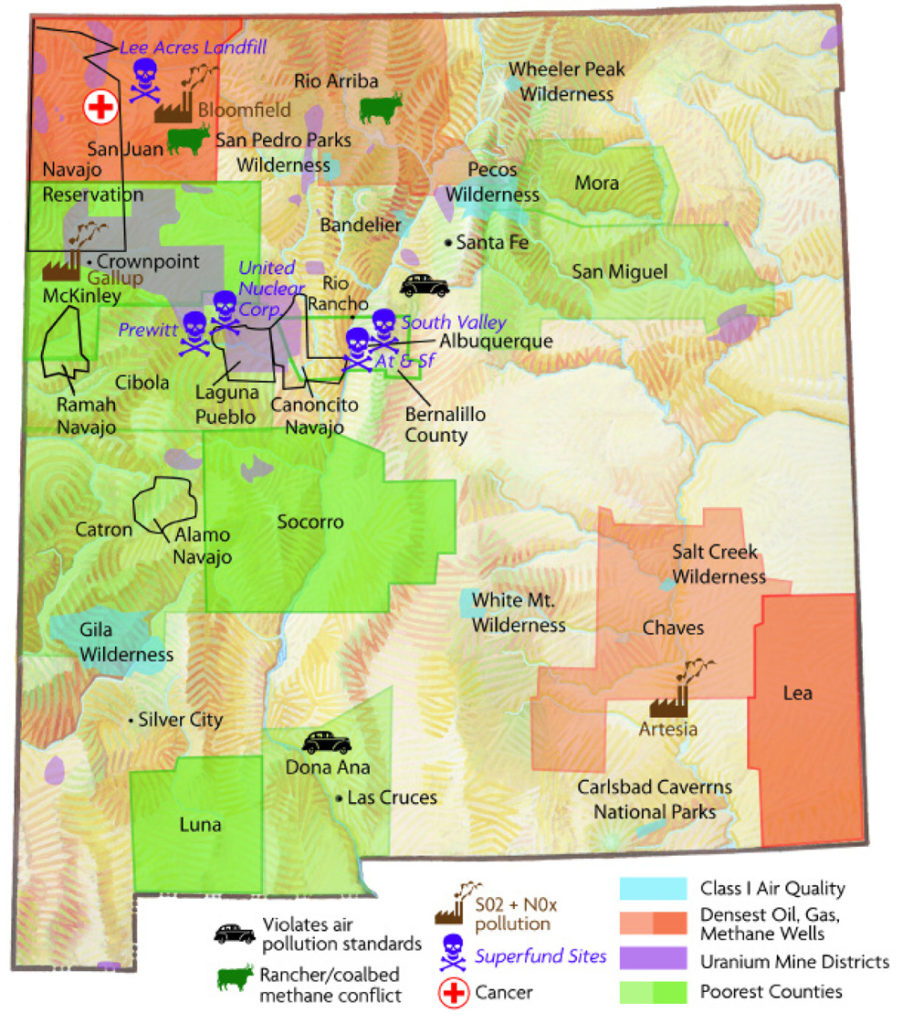Compassionate rules for the most vulnerable
New Mexico dreams of energy development with no harm to citizen health, its lands, waters and property rights. The dream must heal past wrongs and prevent future generations from bearing the burdens of energy system harms. Environmental justice (EJ) puts compassionate working rules for the most vulnerable at the top of its agenda.
As you can see in the map below, the double whammy of poverty and energy development hits the vulnerable parts of New Mexico’s population hardest.

Environmental justice seeks rules for those whose electricity may be cut off because they cannot afford to pay, or strives to deliver food to elders or isolated families who cannot afford transportation. The lack of electricity and gas for heating or cooling can be life threatening. The dream: Every family obtains and maintains utility services or is supplied with off-grid energy; and every family whose bills exceed its ability to pay, knows and can take advantage of a safety net. To achieve affordable utility rates, governments and utilities help low-income homes with energy efficiency costs, which also reduce greenhouse gas emissions.
EJ works to set standards and rules to align energy development with the health, security, and environmental welfare of affected communities. New Mexicans have been hurt by poor mining practices for fossil fuels and uranium, by predatory contracts that did not protect them from neighboring fuel exploitation and water pollution, from abandoned waste sites, and obsolete laws like the Mining Act of 1872 that violates our sense of private property. In our dream, New Mexico heals past and continuing harms that came from the fossil fuel and uranium economies (mine tailings, groundwater pollution and erosion). All energy extraction, processing, transport, use and waste disposal follow rules that keep these activities from harming the citizens, lands and waters of New Mexico. The energy system does not burden this and future generations with costly clean-up costs and legal and health expenditures.
ENVIRONMENTAL JUSTICE FACTS
- Most New Mexicans spend four percent of their income on utility bills. Because New Mexico is the lowest income earner in the nation, about one in five families spends 20% of its income for electricity or gas.
- Over 10,000 New Mexicans, mostly Native American, have no electricity.
- About 40,000 New Mexican homes cannot afford weatherization.
- Navajo miners and civilians have suffered from uranium mining. The Navajo Nation has banned any future uranium mining and fights mining on adjacent lands.
- Galisteo Basin and northern New mexican counties have been threatened by predatory oil and gas contracts that can leave land owners with degraded land and possible health threats.
- Two coal-fired power plants are among the dirtiest in the nation for merucury and greenhouse gas emissions. Coal and gas rich San Juan county also has the highest cancer rates.
- Sulfur dioxide, nitrogen oxides, heavy metals, and radiactive particles from coal are worst in Bernalillo and San Juan Counties.
- Five energy-related superfund sites remain sources of harm (see map shown above).
Uranium Mining + H2O
For 13 years now, people like Mitchell Capitan have been fighting uranium mining in some parts of New Mexico. Hear Mitchell tell of the struggle.
